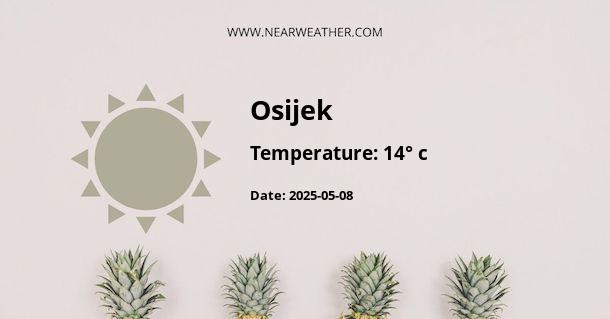The Climate and Weather of Osijek, Croatia: An In-Depth Overview
Osijek is a city located in the eastern part of Croatia, known for its historical sites, cultural events, and as a vibrant economic and academic hub. Beyond its cultural heritage, Osijek's climate is of interest to visitors and residents alike. Understanding the weather patterns and climate characteristics can greatly enhance the experience of living in or visiting this beautiful city. Below, we delve into the details of the climatic conditions you can expect in Osijek throughout the year. We will look at temperature averages, precipitation levels, and other meteorological elements that define Osijek's weather profile.
Geographical Influence on Osijek's Climate
The geography of Osijek plays a significant role in shaping its climate. Situated in the Pannonian Basin and close to the Drava and Danube Rivers, Osijek experiences a humid continental climate (Köppen climate classification: Dfb). This type of climate is characterized by large seasonal temperature variances, with hot summers and cold winters.
Temperature Overview
Temperatures in Osijek fluctuate significantly over the year. Let's break down the temperature trends by season:
- Winter (December - February): Winters are typically cold, with January being the coldest month. Average low temperatures can drop to around -3°C (27°F), while average high temperatures hover around 4°C (39°F). Snowfall is common, and temperatures can occasionally fall below -10°C (14°F).
- Spring (March - May): Spring sees a gradual warming trend. March starts off cool, but by May, average high temperatures can reach 20°C (68°F). However, nights can still be quite chilly early in the season.
- Summer (June - August): Summers are typically warm to hot, with average high temperatures peaking in July at around 27°C (81°F). Heatwaves can push temperatures over 35°C (95°F).
- Autumn (September - November): Fall is characterized by a steady cooling trend. September still enjoys warm weather, but by November, average highs drop to around 10°C (50°F), with lows nearing the freezing point.
"Osijek's seasonal climatic shifts are quite pronounced, making it a place where visitors can enjoy a rich variety of weather conditions." – Local Climatology Expert
Precipitation Patterns
Rainfall in Osijek is fairly evenly distributed throughout the year, with some increases during the late spring and summer due to convective rainfall (thunderstorms). The following points provide an overview of precipitation trends:
- Annual Precipitation: The average annual rainfall is around 650 mm (25.6 inches).
- Wettest Months: June and July are the wettest months, occasionally seeing heavy thunderstorms.
- Driest Months: Early winter and late autumn are typically drier, with February often being the month with the least precipitation.
- Snow: Snow is common in winter months, contributing to the overall precipitation totals during this season.
Wind and Sunlight Patterns
Wind and sunlight exposure affect how people experience the climate. Osijek's wind patterns tend to be gentle to moderate throughout the year and sunlight varies with the seasons:
- Wind Speeds: Average wind speeds are between 10-20 km/h (6-12 mph). North-easterly winds, known locally as "Košava," can be stronger and bring colder weather, especially in autumn and winter.
- Sunshine Hours: Osijek enjoys about 1900 to 2000 hours of sunshine yearly, with the highest numbers in summer and the lowest in winter.
| Month | Average High (°C) | Average Low (°C) | Precipitation (mm) | Sunshine Hours |
|---|---|---|---|---|
| January | 4 | -3 | 35 | 67 |
| February | 7 | -2 | 30 | 96 |
| March | 12 | 2 | 40 | 139 |
| April | 18 | 7 | 50 | 172 |
| May | 23 | 12 | 60 | 229 |
| June | 26 | 15 | 75 | 250 |
| July | 27 | 16 | 70 | 276 |
| August | 27 | 16 | 60 | 263 |
| September | 23 | 12 | 50 | 203 |
| October | 17 | 7 | 40 | 151 |
| November | 10 | 3 | 50 | 94 |
| December | 5 | -2 | 40 | 62 |
Climate Challenges and Adaptations
With the reality of climate change, Osijek, like many other cities worldwide, faces certain challenges in terms of weather extremes and variability. Heatwaves and unpredictable precipitation patterns pose risks to agriculture, infrastructure, and public health. The city is adapting through various resilience strategies such as:
- Implementing green building standards to reduce urban heat effect.
- Expanding green spaces to improve rainwater absorption.
- Investing in flood defenses given the proximity to major rivers.
- Creating public awareness programs on how to stay safe during extreme weather events.
Tourism and Weather Considerations
When planning a visit to Osijek, it is crucial to consider the seasonal weather patterns. For those looking to enjoy outdoor activities and festivals, the best time would be from late spring to early autumn. Winters can be charming, with snow-covered historic sites complementing Osijek's festive mood, but suitable winter attire is necessary.
"Whether it's the vibrant greenery of spring or the crisp snow in winter, Osijek's climate has a special charm in every season, making it a year-round destination for those who are prepared." – Travel Advisor Specializing in Croatian Destinations
In conclusion, the climate and weather of Osijek provide a diverse and dynamic canvas that reflects the changing seasons. This information should serve as a valuable guide for residents, travelers, and enthusiasts looking to understand and experience Osijek's vibrant weather patterns. For the most accurate and current weather forecasts, we recommend consulting local meteorological services or reliable online weather platforms.
A - Osijek's Latitude is 45.551109 & Longitude is 18.693890.
A - Weather in Osijek is 5° today.
A - Climate Conditions in Osijek shows fog today.
A - Humidity in Osijek is 93% today.
A - Wind speed in Osijek is 7.42 km/h, flowing at 120° wind direction. today.
